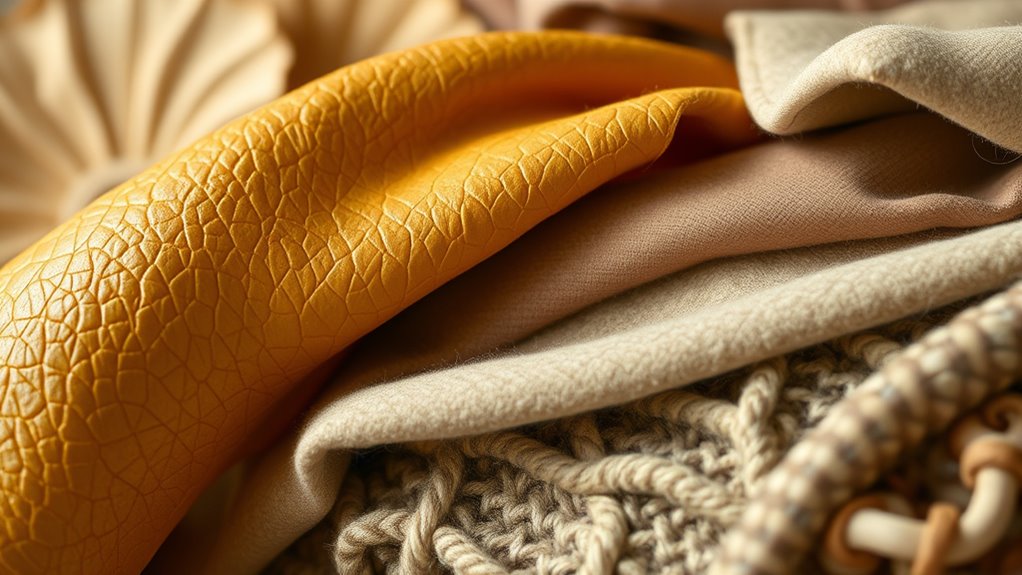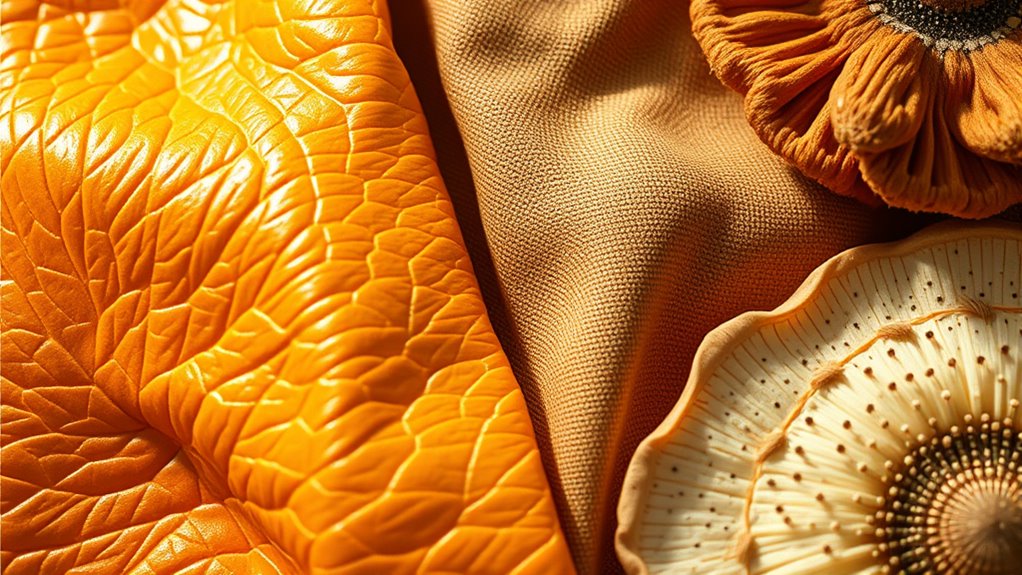Discover innovative, eco-friendly materials like pineapple leather, made from agricultural waste, and mushroom fabrics derived from sustainable fungi. Cork offers a renewable, biodegradable option, while recycled plastics help reduce waste and conserve resources. These materials are versatile, resource-efficient, and support circular economies, making them perfect for sustainable fashion and design. Exploring these options further unravels new possibilities for responsible creativity and eco-conscious innovations.
Key Takeaways
- Sustainable alternatives like pineapple leather, mushroom fabrics, cork, recycled plastics, and plant-based dyes reduce environmental impact and resource consumption.
- These innovative materials utilize agricultural waste, are biodegradable, and support circular economy principles.
- Mushroom fabrics and pineapple leather offer versatile applications in fashion, accessories, and home decor.
- Sustainable sourcing practices ensure minimal harm to ecosystems, such as non-destructive cork harvesting and eco-friendly cultivation.
- Incorporating these eco-conscious materials aligns with market trends favoring responsible, innovative products.

As the demand for sustainable solutions grows, exploring alternative materials becomes essential. You’re likely aware that traditional manufacturing often relies on resource-intensive processes and environmentally harmful practices. To address this, many designers and brands are shifting toward innovative, eco-friendly options that prioritize sustainable sourcing and eco friendly production. These alternatives not only reduce environmental impact but also open new creative avenues, allowing you to craft products that are both stylish and responsible.
Pineapple leather, also known as Piñatex, exemplifies this approach. Made from the fibers of pineapple leaves, it offers a sustainable sourcing alternative to conventional leather. By utilizing agricultural waste, this material prevents wastefulness and reduces the need for resource-heavy animal farming. When you choose pineapple leather, you’re supporting eco friendly production methods that minimize water usage and chemical treatments often associated with traditional leather manufacturing. Its durability and natural aesthetic make it an appealing choice for footwear, accessories, and apparel, all while aligning with eco-conscious values. This material exemplifies how you can incorporate sustainability into your designs without sacrificing quality or style.
Pineapple leather offers a sustainable, stylish alternative to traditional leather, supporting eco-friendly production and reducing environmental impact.
Similarly, mushroom fabrics, or mycelium-based textiles, are gaining popularity as versatile, eco-friendly materials. They are cultivated from fungi, which grow rapidly and require minimal resources. When you opt for mushroom fabrics, you’re engaging in sustainable sourcing that leverages renewable biological materials, reducing reliance on synthetic fibers or resource-intensive crops. The production process is relatively low-impact, involving fermentation and minimal chemical use, therefore supporting eco friendly production practices. These fabrics can be processed into soft, flexible textiles suitable for clothing, bags, and home decor. Their biodegradability ensures that, at the end of their lifecycle, they won’t contribute to long-term pollution, making them a responsible choice for environmentally aware consumers and designers alike. Additionally, embracing innovative materials can help differentiate your brand in a competitive market focused on sustainability.
Beyond pineapple leather and mushroom fabrics, other innovative materials like cork, recycled plastics, and plant-based dyes are making their mark. Cork, harvested from the bark of cork oak trees, offers a renewable, biodegradable option that supports sustainable sourcing by ensuring the trees are not harmed. Recycled plastics repurpose waste materials into new products, reducing landfill accumulation and conserving virgin resources. Plant-based dyes replace traditional chemical dyes, decreasing water pollution and exposure to toxic substances in eco friendly production processes.
Frequently Asked Questions
How Durable Are Pineapple Leather and Mushroom Fabrics?
Pineapple leather and mushroom fabrics are quite durable, though their lifespan varies. Pineapple leather tends to be more resistant to scratches and wear, making it comparable to traditional leather, but it may not last as long with heavy use. Mushroom fabrics are softer and eco-friendly but can be less durable over time. Overall, their durability comparison depends on usage, but with proper care, you can extend their material lifespan considerably.
Are These Alternative Materials Eco-Friendly Throughout Their Lifecycle?
You’ll be glad to know that pineapple leather and mushroom fabrics are generally eco-friendly throughout their lifecycle. About 90% of their environmental impact comes from sourcing sustainability, as they use agricultural waste and fungi instead of traditional resources. These materials reduce water use, emissions, and chemical treatments, making them a more sustainable choice. By choosing them, you support a lower environmental impact and promote sustainable sourcing practices.
Can These Materials Be Recycled or Composted After Use?
You can often recycle or compost these alternative materials, but it depends on their specific composition. Pineapple leather and mushroom fabrics are more likely to be composted if they’re free of synthetic coatings, reducing their environmental impact at end-of-life disposal. However, some may require specialized recycling processes, which can impact their overall eco-friendliness. Always check manufacturer guidelines to guarantee proper disposal and minimize environmental impact.
How Do the Costs Compare to Traditional Leather and Fabrics?
You’ll find that the cost comparison between alternative materials like pineapple leather and mushroom fabrics and traditional leather or fabrics varies. Generally, these eco-friendly options tend to be more expensive initially due to smaller market sizes and production costs. However, as demand increases and manufacturing scales up, market prices could decrease, making them more competitive. You should consider both environmental benefits and long-term value when evaluating costs.
Are There Any Health or Allergy Concerns With These Materials?
You might find these innovative materials gentler on your body, but they could pose allergy risks or trigger chemical sensitivities for some. While they’re generally considered safe, certain individuals with sensitivities should check for potential allergens or chemicals used in processing. Always test a small area first, and consult product info or a healthcare professional if you have concerns. Staying informed helps you enjoy these eco-friendly options safely.
Conclusion
By exploring these innovative materials like pineapple leather and mushroom fabrics, you’re stepping into a future where sustainability isn’t just a trend but a revolution. Every choice you make can dramatically reduce environmental impact, transforming the fashion industry from a polluter to a pioneer of change. Embrace these alternatives, and you’ll be part of a movement so powerful it could reshape our planet’s destiny—proof that your decisions truly have the potential to change everything.









